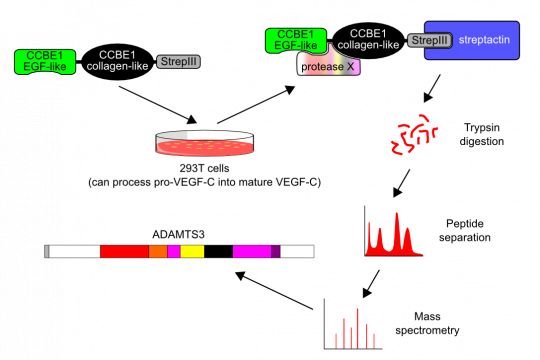The molecular basis of Hennekam syndrome

Finally our CCBE1 manuscript is out! You can access it from the Circulation's homepage (if your library does not have a subscription, just drop me an e-mail). It nicely complements the article by Le Guen et al. from Ben Hogan's group in Development. While Le Guen and colleagues analyzed the interaction of CCBE1 with the VEGF-C/VEGFR-3 pathway mainly at the genetic level in zebrafish, we tried to describe the molecular details of the interaction using in vitro assays which we complement with in vivo mouse data.
We describe that the primary lymphangiogenic factor VEGF-C is produced as an inactive precursor (pro-VEGF-C). Pro-VEGF-C (that is the 29/31-kDa-form) does bind to VEGFR-3 on endothelial cells, but is unable to activate it. Until now, the common wisdom was that pro-VEGF-C is only a less potent activator of VEGFR-3 than mature VEGF-C. In fact, it actually acts as a competitive inhibitor of mature VEGF-C. The task of CCBE1 is to assist the ADAMTS3 protease in cleaving cell-surface bound pro-VEGF-C and thus to localize the concentration of active VEGF-C.
In hereditary diseases that are caused by mutations in CCBE1 (Hennekam syndrome), this activation of VEGF-C is impaired and causes lymphedema. Because of the importance of lymphatic vessels in many diseases, CCBE1 and ADAMTS3 are interesting drug targets. In cancer, for example, it would be a tremendous benefit if one could prevent the activation of VEGF-C and thus prevent VEGF-C-mediated metastasis. I am also going to present this data at the next Gordon Research Conference on Lymphatics in Italy in a few weeks as a poster (see below). Our data is definitely interesting enough to be selected as a short talk!



